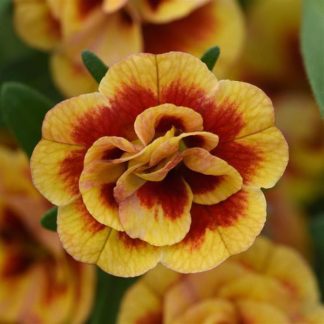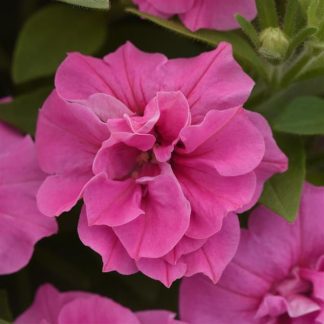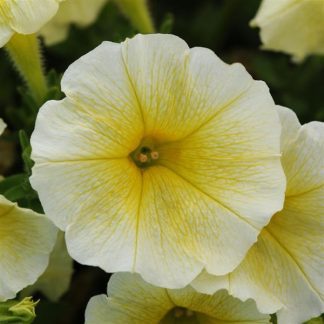Description
Calibrachoa ‘Double Lemon’: Little Trumpets of Sunshine for Every Gardener
Welcome to a Burst of Yellow Joy
You and I both know how a single color can change a whole garden. A bright yellow bloom can chase away a gray mood, highlight an overlooked corner, and invite butterflies to linger. Calibrachoa ‘Double Lemon’ does all that—and more. In other words, this petite plant offers rich color and generous blooms without asking for much in return. We are about to dive deep into its story, shape, and simple care. Grab your favorite drink, find a cozy seat, and let’s celebrate this sunny wonder together.
Meet Calibrachoa ‘Double Lemon’
Calibrachoa, often called “mini-petunia,” is famous for waves of color and nonstop flowers. ‘Double Lemon’ takes that fame a step further. Instead of a single flower layer, each blossom opens with two tidy rows of petals, creating a miniature rose effect. The petals shine in a clear, buttery yellow that stays bright, even under strong sun.
A Quick Snapshot
- Botanical family: Solanaceae
- Common names: Million Bells, mini-petunia
- Growth habit: Trailing to mounding, 6–10 inches tall, spreading 12–18 inches wide
- Bloom season: Late spring through first frost
- Flower form: Double, ¾–1 inch across, funnel shape with rounded petal tips
- Color tone: Warm, sunny yellow with soft highlights that glow at dawn and dusk
Why Double Blooms Matter
A double flower is more than a style choice. Extra petals add depth, catching light in interesting ways. Bees still find their way inside, yet the blossom lasts longer because the extra layers slow down wilting. That means more petals per plant, more photo moments for you, and more nectar pauses for hungry pollinators.
A Friendly Personality
‘Double Lemon’ fits easily into mixed baskets, raised beds, window boxes, and garden edges. Its stems drape softly over container rims but do not sprawl so far that they look messy. After more than one season of trials, many growers praise the plant’s balanced look: full at the crown, arching at the tips, and always dotted with blooms.
The Many Roles ‘Double Lemon’ Plays
Color Anchor in Planters
Yellow pairs well with nearly every hue. Place ‘Double Lemon’ with purple verbena, deep blue lobelia, or hot-pink geraniums for striking contrast. Instead of clashing, the yellow seems to pull the whole combo together.
Spotlight in Small Spaces
Have a balcony with room for just one pot? Pick this plant. Its cheerful color draws the eye, so even a single specimen can feel like a full arrangement.
Pollinator Buffet
Tiny double flowers might look delicate, but they still provide nectar. Butterflies often circle back for several sips. Bees, especially small native species, slip between petals with ease. By planting a row of ‘Double Lemon’, you create a tasty runway that keeps pollinators in your yard longer.
Seasonal Bridge
Garden beds can slump between spring bulbs and midsummer perennials. Calibrachoa fills that gap. In early May, when tulip foliage starts to yellow, tuck ‘Double Lemon’ around the fading leaves. The fresh growth hides the mess, and the flowers pick up where the bulbs left off, keeping color alive all season.
How to Care for Calibrachoa ‘Double Lemon’
Light: Bright but Gentle
- Ideal: Full sun, at least six hours daily
- Still okay: Morning sun plus afternoon dappled light
- Watch out: Dense shade reduces bloom count
Sun drives flower production. Yet in regions with searing summers, noon shade can protect the foliage from stress. In other words, let the plant bathe in sunshine early, then offer a light umbrella of taller plants or an awning during peak heat.
Soil: Airy and Well-Drained
Calibrachoa roots crave oxygen. A standard potting mix with extra perlite works wonders. If you garden in the ground, amend heavy soil with finished compost and coarse sand. Raised beds with loose, crumbly texture make roots happiest.
pH sweet spot: 5.5–6.2 (slightly acidic). When soil drifts above 7.0, iron becomes hard to access, and leaves may yellow. A yearly sprinkle of peat moss or pine-based compost helps keep the balance lean toward acid without harsh chemicals.
Watering: Consistent Moisture, Never Soggy
Imagine a moist sponge: springy and damp but not dripping. That is the feel you want around the roots. Water deeply until liquid flows from drainage holes, then wait until the top half-inch of mix feels dry before the next soak. In containers, that often means watering once every day or two during high summer. Instead of a fixed schedule, use your finger as a gauge.
Feeding: Steady Snacks Over Big Meals
Calibrachoa pumps out hundreds of blooms, and each one needs energy. A slow-release fertilizer blended into the potting mix sets a solid base. After more than six weeks, begin weekly half-strength liquid feeding. Choose a balanced formula (for example 10-10-10) with added micronutrients. Iron and magnesium in particular keep foliage deep green.
Temperature and Humidity: Goldilocks Range
- Happy zone: 55 °F to 75 °F
- Tolerable spikes: Up to 85 °F with shade and moisture
- Hard stop: Frost (32 °F)
In humid summers, good airflow becomes vital. Space plants a hand’s width apart so leaves dry quickly after rain. Where nights stay muggy, an oscillating fan on a porch can prevent fungal growth in hanging baskets.
Pruning and Deadheading: Gentle Pinching
Calibrachoa is often labeled “self-cleaning” because spent blooms fall away on their own. Still, a mid-season haircut energizes the plant. Around late July, trim back each stem by one-third. New shoots soon appear, carrying a fresh rush of flowers.
Overwintering: Save, Store, or Start New
In USDA zones 9-11, ‘Double Lemon’ can survive winter outdoors with mulch. Elsewhere, treat it as an annual or bring a few cuttings indoors. Potted plants can live under bright shop lights in a basement window, watered lightly every two weeks. By February, pinch the tips to spur branching, then move the pot outside after the last spring frost.
Common Issues and Simple Solutions
| Problem | Symptom | Cause | Quick Fix |
|---|---|---|---|
| Iron chlorosis | Yellow leaves with green veins | High pH or soggy soil | Check drainage, water with iron chelate |
| Botrytis blight | Gray fuzzy spots on petals | Humid, still air | Remove damaged blooms, improve airflow |
| Aphids | Sticky leaves, twisting shoots | Soft green or black bugs | Spray with a mild soap solution |
| Root rot | Wilting despite wet soil | Waterlogged mix | Repot in fresh, airy soil and cut back on watering |
Instead of waiting for trouble to spread, walk by your plants every two days. Turn leaves over, look under rims, and enjoy the close-up view. Early action keeps the garden healthy and your mind at ease.
Propagation: Growing More Sunshine
Tip Cuttings
- Snip 3- to 4-inch non-flowering tips.
- Remove the lower leaves.
- Dip in rooting powder.
- Insert into damp, sterile mix.
- Cover with a clear dome or plastic bag to raise humidity.
Roots form in 10–14 days. After more than three weeks, transplant each rooted cutting into its own pot. Keep under bright indirect light until outside temperatures settle above 55 °F at night.
Seed? Not This Time
Calibrachoa hybrids rarely produce seed that grows true to type, and double forms are even less reliable. Cuttings give you a perfect clone of the parent plant every time.
Design Ideas and Pairings
Container Combos
- Sunny Citrus Splash: ‘Double Lemon’ + orange African marigold + lime-green sweet potato vine
- Cool Sunrise Mix: ‘Double Lemon’ + lavender angelonia + blue scaevola
- Evening Glow Basket: ‘Double Lemon’ + burgundy coleus + white bacopa
Garden Bed Partners
Pair ‘Double Lemon’ with sage leaves, dusty miller, or silver artemisia. The gray tones make yellow pop. After more than one season, many gardeners note that such blends look fresh into fall because the foliage framework stays steady when other blooms slow.
Kid-Friendly Planters
Children love bright colors and quick rewards. Fill a low tub with ‘Double Lemon,’ strawberry plants, and trailing mint. Kids can nibble berries, sniff mint, and watch bees hover over the little yellow trumpets—all in one reach.
Year-Round Calibrachoa Calendar
- Early Spring: Start cuttings, refresh potting mix, add slow-release fertilizer.
- Mid-Spring: Harden off plants outside; plant after last frost.
- Late Spring: Begin weekly feeding; watch for aphids as temperatures rise.
- Early Summer: Water deeply; apply a light mulch on container soil.
- Mid-Summer: Trim stems by one-third; renew feeding routine.
- Late Summer: Continue watering; enjoy peak bloom.
- Early Fall: Reduce feeding; remove tired stems.
- Late Fall: Anyone in frost-free zones can leave plants in place. In colder areas, take cuttings or allow plants to finish naturally.
Following this simple rhythm keeps maintenance light and results bright.
Troubleshooting Myths
- “Double blooms need more fertilizer.” Not true. They need steady, but not heavy, feeding. Too much nitrogen can actually reduce flowers.
- “You must deadhead every day.” Not for Calibrachoa. Most spent blooms drop on their own.
- “Yellow flowers fade faster.” ‘Double Lemon’ is bred to keep its warm tone under strong sunlight. Fading is minimal when the plant stays healthy.
- “Calibrachoa can’t handle rain.” Regular rain is fine. Just avoid waterlogged soil.
In other words, stay curious, but do not let hearsay worry you. Your own observations guide the best care.
Bringing It All Together
Calibrachoa ‘Double Lemon’ is proof that great beauty can be easy. We choose it for the sunny color, the refined double petals, and the way it fills containers with grace. We keep it happy with simple steps: bright light, airy soil, even water, and small weekly feeding. In return, the plant rewards us with blooms from spring’s gentle start until autumn’s cool sigh.
Think of every flower as a tiny trumpet celebrating your care. Instead of demanding exacting rituals, this plant invites you to enjoy the process—pinch here, water there, smile often. By adding ‘Double Lemon’ to your garden or balcony, you build a living spotlight that lifts moods and welcomes pollinators. After more than one season together, you might find yourself planning whole color schemes around its glowing petals.




